AMK 1/48 Aero L-29 Delfin
The Aero L-29 Delfin (Dolphin)was Czechoslovakia's first locally-designed and built jet aircraft, and became the standard jet trainer for all Warsaw Pact air forces (other than Poland) during the 1960s. The prototype XL-29, designed by Z. Rublic and K. Tomáš, first flew on 5 April 1959, powered by a British Bristol Siddeley Viper engine. The second prototype was powered by the Czech-designed M701 engine, which was used in all subsequent aircraft. The basic design concept was a straightforward, easy-to-build and operate aircraft. Simplicity and ruggedness were stressed with manual flight controls, large flaps and the incorporation of perforated airbrakes on the fuselage sides to provide stable and docile flight characteristics, As a result, the L-29 had an enviable safety record. The sturdy L-29 was able to operate from grass, dirt or unprepared fields. Production commenced in April 1963, with 3,600 L-29s built by 1974, of which 2,000 were taken on charge by the Red Air Force.
The Delfin could be used for weapons training, and was equipped with hardpoints to carry gunpods, bombs or rockets. Armed Egyptian L-29s were used against Israeli tanks during the Yom Kippur War. The type also saw combat alongside the late L-39 Albatross in ground attack missions by the Azeri Air Force during the Nagorno-Karabakh War. At least 14 were shot down by Armenian air-defenses, out of the total Azeri inventory of 18 L-29's. On July 16, 1975, a Czechoslovak Air Force L-29 shot down a Polish AN-2 piloted by Dionizy Bielanski, who was attempting to defect to the West. The Russians claim to have destroyed two Georgian L-29s during the 2008 South Ossetia war, and the Separatists in the current Ukrainian Civil War claimed to have an operational L-29 in use on January 18, 2015. After the splitting of Czechoslovakia into the Czech and Slovak Republics, the Slovakian Air Force operated 16 L-29s until 2003.
On September 14, 2008, two L-29s took first and second place at the Reno Air Races, with both aircraft consistently posting laps at or above 500 miles per hour. Former Astronaut Curt Brown took first place in "Viper," followed by Red Bull racer Mike Mangold in "Euroburner."
There is a 1/32 all-resin L-29 that was released a few years back by HPH, and Planet Models also released 1/48 and 1/72 L-29 resin kits. Bilek released an L-29 in 1/72 injection plastic, as did KP Models. AvantGarde Model Kits of China released this 1/48 injection molded L-29 in 2014.
The AMK kit is a very high-quality design. The clear canopy parts are optically perfect. All the surface detail is in petite engraved-line work. All parts are crisply molded and there is no flash to be seen anywhere. Decals are provided for seven different schemes: 3 silver (Soviet, Czechoslovak and Iraqi air forces), 2 grey (Czech Republic and Indonesia) and 2 camouflaged (East Germany and Slovak Republic). A small photo-etch fret is proved for detail parts, primarily in the flap well. All control surfaces are molded separately, and there is no difficulty in assembly with the flaps up or down (generally if flaps-down are provided, this is the that is most workable). The seven page instruction booklet is clear and very user-friendly with full color painting and markings instructions.
I followed the kit instructions and began with the cockpit. There is not a lot of detail provided, but what is there is sufficient. There is an L-29 out at Planes of Fame which I examined shortly after this kit arrived at the all-new Le Chateau du Chat, and the actual cockpit is not all that "busy" itself. The seats are accurate, and the instrument panel decal provides sufficient detail. The kit instructions call for a light grey cockpit interior - when I looked at the one out at Chino, it had a cockpit that color, but the more typical Soviet "cockpit blue" had been overpainted, so they likely can be done both ways and I would go with the blue if doing a Red Air Force L-29.
The really nice thing about this kit is that everything assembles very easily. All the parts fit very precisely, and if you exercise care, you will not need any putty or seam filler anywhere. Follow the very logical instructions and you will have no difficulties anywhere in the construction process.
I used fishweights pressed flat with pliers to provide the necessary weight for nose-sitting. Cramming sufficient weight under the cockpit tug and immediately behind it was the one hard part of the whole assembly.
To me, the all-silver and all-grey options resulted in a very drab look. It would have been nice to have the option of doing one or more of the many aerobatic teams that used the L-29, but in the end I opted for the Slovakian L-29 with tri-color upper camouflage. After pre-shading the model, I painted it freehand using Tamiya paints - Buff, Hull Red, and RAF Dark Green, with a Light Grey lower color.
The decals are excellent quality and go down under a coat of Micro-Sol with no problem. I attached the landing gear, and unmasked the canopies, which I posed in the open position.
This AMK kit is highest-quality and a real bargain at only US$40.00, creating a very nice model of an airplane that most certainly has not been "done to death." I have also received the 1/48 Kfir C2 and Fouga Magister kits that AMK have released in the past year. These kits came out nearly simultaneously with those of the same subjects by Kinetic. I can say having looked at both the Kinetic kits and these kits that the AMK kits provide finer detail (the Magister has complete engines and can be assembled with panels open) than their Kinetic competitors. AMK is set to release a 1/48 MiG-31 that I am willing to bet will be one of the best modern Soviet aircraft kits available when it comes out. This L-29 is highly recommended to anyone interested in trainers, Eastern bloc aircraft, or out of the ordinary subjects.
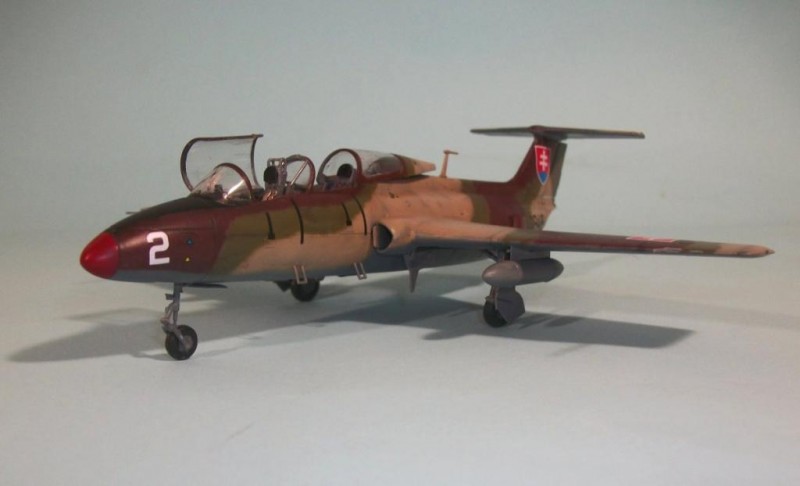
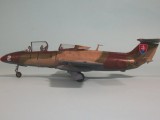

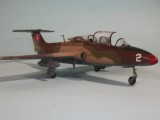
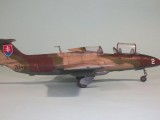
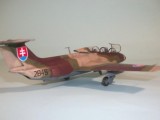
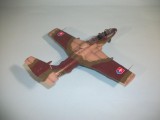
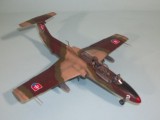
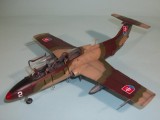
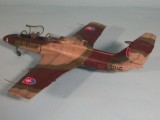
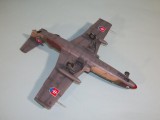
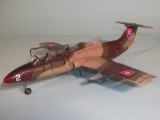
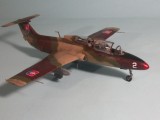

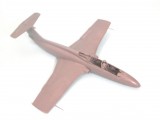
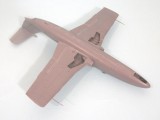

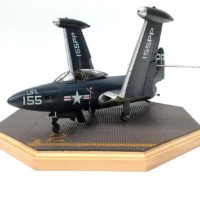

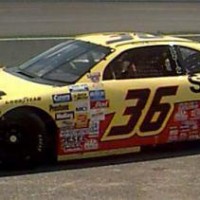
An excellent build, Tom. The camo and the markings really work well together. A great introduction to this aircraft type.
I've had several opportunities to see this aircraft up close and personal and its easy on the eyes. Rarely, do I buy a kit before I do some research and pricing but, I went and purchased one right away. A excellent build and its great to see the miracles of medical science give out a new lease on life and correct the vision of a gift modeler.
Two thumbs up on this one TC.
Tom, what a beauty! I'm amazed that they did one in 1/48th, finally. The color scheme and markings really set it off.
I'm gonna get me one of them!
I remember when all you could find on WARPAC airplanes was grainy photos taken on May Day, with "guesstimate" drawings thereof. The models of the time were of the sorta close, but... variety.
It's a great time to be a modeler!
Greetings :
Interesting build and kit. That is one of the aircraft that has been neglected ( at least in this scale ), it sure fills that void nicely. Well done.
Nice build of a plane I'm not familiar with. Your narrative is always appreciated and educational!
Tom - very nice. I've got the 1/72 version (either Bilek or KP - can't remember which), and I think you're rendition has tipped the scales as to the scheme I'll use. This one looks very nice! Great weathering/shading also.
sweet...for some reason it looks like a cross between a bronco and a banshee a starfighter tail...a cougar with p-51 wings...very cool
Yeah, for some reason it just has a really pleasing shape. I was completely unfamiliar till I saw the marvelous 1/32 model here, and then got this, and then looked at the real one out at Planes of Fame. It's one of those airplanes that is nice to look at. I like it a lot better than the L-39 Albatross, even if it is a higher performer.